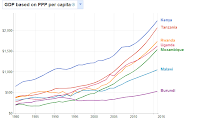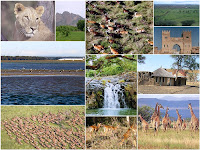 |
| IMF forecast |
According to the IMF,
there is now fast economic growth in East Africa. All countries in East Africa are reportedly doing very well. In reality, are East African countries truly doing well? Are lives improving?
All East African countries are indeed growing; they are all projected to grow by about 5% this year and the coming few years. But then, look at the region's GDP based on PPP per capita; considering how fast the population is growing in the region, the economic growths are not that impressive: in 2016 - Kenya's GDP will reach about $2,500 while Burundi's, the poorest country in East Africa, will hover at about $500. Compare that to (in 2009): South Africa's or Botswana's - both at about $10,000; or Seychelles, with about $30,000; or the richest country in the world - Qatar, which has about $74,000.
 |
| Gapminder: HIV trends |
Ever heard of
Gapminder? It is an amazing, superb tool that provides you with such a variety of statistics, charts and data, and in such an interesting, entertaining way - that you can't help, but be glued to it for hours. It is while looking at statistics and data on Gapminder, that the projected growth for East Africa doesn't impress much.
For instance, HIV is still and will remain a very weakening factor for most of Eastern and Southern Africa. Most of these countries
have been quite successful in providing treatment for those infected, the death rate due to AIDS has fallen - but
they still have quite a high percentage of infected people even if the number of new infections is falling. Though smallpox has been eradicated and the
Guinea worm eliminated in many African countries, diseases, poverty, poor governance and conflicts are still most weakening for Africa. In almost all of Gampinder's statistics, data and forecasts - sub-Saharan African countries, including Eastern Africa, are the worst performers and will be so for years to come.
+ East Africa Economic outlook




